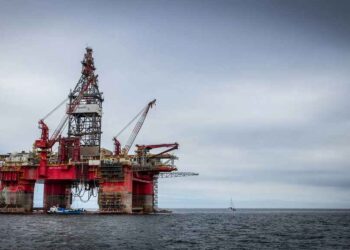As crude oil prices rise, the price of natural gas follows and gas resources start to become more economically viable. In Alaska, crude oil production from Prudhoe Bay is now in decline so gas could take over.
Alaska is a gas-rich state, but the problem has always been how to retrieve the gas and deliver it to the customer at an economic price. A project that has long been held in abeyance is the Alaska Gas Pipeline, which has been resurrected since its first inception and appears to be heading towards construction, despite estimated costs of around $30bn.
The project is controlled by the Alaska Governor’s office, the Alaska Gasline Port Authority and the Alaska Natural Gasline Development Authority.
Alaska Gas Pipeline project
“Alaska is a gas-rich state, but the problem has always been how to retrieve and deliver it to the customer economically.”
The basic project involves the construction of a gas pipeline to transport natural gas from the large Alaska North Slope reserves to the lower 48 states.
The known natural gas reserves available in the North Slope are estimated to be around 35 trillion cubic feet (currently this is being left dormant or being reinjected into oil fields). There are expected to be many times more as yet undiscovered reserves of gas in Alaska’s North Slope – the known reserves would only give 18 months’ supply to the US at current rates of consumption.
The pipeline and associated facilities required around nine to ten years to construct and the timeline for finishing the project was tentatively placed at 2017-18, at which point four billion cubic feet of gas would be transported a day. It was estimated that the pre-construction work required the securing of over 1,000 permits from local, state and federal authorities in both the US and Canada.
The engineering and construction would have seen a 2,000-mile pipeline built stretching from the North Slope in Alaska to the Canadian Province of Alberta, and then later a possible 1,500-mile extension to Chicago (the trans-Alaskan pipeline for crude oil is only 800-miles long and there would be at least five Alaskan take-off points).
The estimated cost of the project was around $20bn in 2001, but the rising cost of steel, other materials and labour could inflate the final cost. The State of Alaska has said that it will provide assistance in funding the project although would expect the majority of funding from the oil / gas companies involved (the state has offered $500m but this has been turned down by the project participants as it would introduce delays).
The gas from Alaska is needed to feed North American gas consumption, which rose by 6.2% in 2007 to a record high of 23 trillion cubic feet (the 2006 figure was 21.7 trillion cubic feet).
Project details
BP and Conoco Phillips (which both own North Slope gas reserves) spent three years and $165m working on support for the project (Denali Project). In May 2011, however, they decided to scrap the project due to poor customer demand.
The pipeline and associated facilities required around nine to ten years to construct, and the timeline for finishing the project was tentatively placed at 2017-18, at which point four billion cubic feet of gas would be transported a day. It was estimated that the pre-construction work required the securing of over 1,000 permits from local, state and federal authorities in both the US and Canada.
The engineering and construction would have seen a 2,000-mile pipeline built stretching from the North Slope in Alaska to the Canadian Province of Alberta and then later a possible 1,500-mile extension to Chicago (the trans-Alaskan pipeline for crude oil is only 800 miles long and there would be at least five Alaskan take-off points).
TransCanada proposal
As well as the pipeline proposed by BP Conoco Phillips, the TransCanada and ExxonMobil joint venture also put forward a project proposal, which was accepted by the Governor of Alaska in 2009. This project would require an investment of $32bn-41bn to build a pipeline from Prudhoe Bay to Alberta.
The planning, which cost around $625m (state money), started in 2009 and construction, if all goes well, is expected to be completed by 2021. The project currently only includes the pipeline and no gas processing plant. In addition, TransCanada does not actually own any gas reserves on the North Slope as these are under the control of ExxonMobil, BP and Conoco Phillips.
The initial open season was completed between May and July 2010. FERC filing is expected to be completed by October 2012. EPC work is expected to begin in 2014 and the project sanction is expected in mid-2015. First gas is expected by mid-2020 and full gas by mid-2021
“In Alaska crude oil production from Prudhoe Bay is now in such decline that gas could soon take over.”
It is possible that TransCanada and the other consortium could merge their projects and build the pipeline together in cooperation. TransCanada do have two pieces of legislation in their favour, the first being the AGIA (Alaska Gasline Inducement Act) of 2007 which could present them with a State licence and hence a subsidy (BP-Conoco have turned this down) and also the 30 year old Canadian Northern Pipeline Act which supposedly confers rights to build such a pipeline across Canadian territory (this remains to be tested).
The AGIA was bid for by Sinopec, AEnergia LLC of California and also TransCanada.
Another proposal
In a further twist, the Governor of Alaska also asked for a study to be carried out (costing $8m) to examine the possibility of bringing a bullet line (smaller pipeline) from the North Slope reserves to supply Fairbanks, Anchorage and south central Alaska with a new gas supply.
The current supply from the Cook Inlet is running out and a new supply has to be found. This would function concurrent to any other larger pipeline constructed later on. Although even for this smaller scale project the costs of construction could approach $3bn.

















































